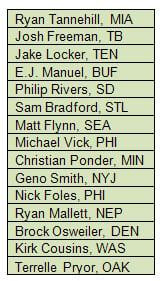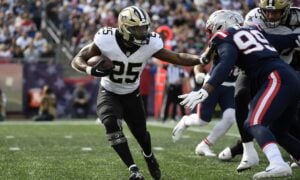Ranking by Positional Role
Editor’s Note: This particular article is submitted by a new Member Corner author, Mike Reardon. We welcome Mike to the Member Corner and look forward to seeing more of his work in the future!
As with most dynasty players, I began my fantasy football career in the re-draft world. It was a few years before I even discovered the dynasty format and finally tried it out. At the time, there were barely any dynasty-specific resources available, so I basically just took the approach I had in re-draft leagues and tried to apply it to the dynasty setting. The dynasty game has matured quite a bit since then and experienced a drastic increase in popularity, but I still think there is a tendency in the fantasy community to take tools from the re-draft world and apply them to the dynasty world with little or no modification. The most obvious example of this to me is player rankings.
While player rankings can be useful in a dynasty setting, I believe that the way most people create them (QBA is better than QBB is better than QBC, etc.) ignores the fact that in dynasty leagues, players have multi-dimensional value that requires a deeper level of analysis than simply which player is “better” than the other. What does “better” even mean? Are we talking about year one production? The next three years of production? Upside? Trade value? The absence of these considerations in a re-draft league is what makes linear rankings very useful in that setting, but a wholly inadequate tool when it comes to dynasty leagues.
One way I think your own rankings can be enhanced is by acknowledging the existence of different player roles on a dynasty roster. Perhaps the most effective way to explain what I mean is by starting with an example. For instance, I think it makes very little sense to have Peyton Manning and Ryan Tannehill ranked against each other on the same list reflecting dynasty value.
When you draft Manning, you’re taking a starter. You want him under fantasy center from day one and hope to ride him until he ages out of elite fantasy production. When you take Tannehill, you probably love his potential and believe he has near-elite upside, but you really don’t want to roll him out with Adrian Peterson, Percy Harvin and the rest of your starting lineup in week one in 2013.
So, why are we comparing these two players? The easy answer is because they are both quarterbacks, but I propose just because they play the same position in the NFL does not mean they play the same role in your dynasty roster. The primary factor determining how you value them relative to each other is what your team needs. If you took Drew Brees somewhere in the first few rounds of a start-up, it makes very little sense for you to grab Peyton Manning later in the draft (unless you’re making a play for future trades, which I believe is a risky strategy). You already have a starter who will put out elite level production, so there’s no need for you to spend a pick on another elite player whose performance and value will likely decay before you need to replace Brees.
On the other hand, Tannehill is the ideal type of player to pair with Brees. You don’t need to start him right away while Brees is still in his prime, so you can afford to keep him on the bench and wait. Ideally, he matures and develops in two-to-three years and is ready to take over the reins when Brees is winding down, providing your fantasy team with a seamless transition from old to new, without having to endure the fantasy equivalent of the Curtis Painter-era like the Indianapolis Colts did.
When you consider 99% of fantasy experts have Peyton Manning ranked ahead of Ryan Tannehill, you start to see the problem with rankings being so one-dimensional. Manning vs. Tannehill is not an apples-to-apples comparison, so it makes little sense to have them on your final hierarchical list ranking the quality of, well, apples.
Instead of lumping these two players (and all quarterbacks) into one list, it could make sense to create rankings reflecting the reality that different players will have different roles on your dynasty team, even if they play the same position. In short, we need to break up the quarterback position into more than one group.
Now, please note that this is not the same thing as tiering, which is a very useful tool in its own right. Tiering is grouping players together based on relative value; it is still an expression of quality (i.e. “these quarterbacks are better than these quarterbacks”) and still lumps all players together based on their NFL position. What I’m talking about is breaking apart the quarterback position into subdivisions to properly account for the different roles they could play in the context of your dynasty roster. It’s a division based on the type of value a given player provides, not the quality.
Sticking with quarterbacks, the first group would simply be called “Starters.” Starters are players who are producing right now at a level sufficient to be a regular starting player for your fantasy team, in the context of your league parameters. They may still have more upside and room to grow, but even if they stay at their current level of production, they’ll be good enough to start.
Sticking with the quarterback discussion, here are the players I would feel comfortable with in a starting role on my dynasty team:
Putting specific players rankings aside, these are the players who I believe can fill the starting role on my dynasty team, and therefore it makes sense to me to rank them against each other. I’ll also mention I believe it would be entirely appropriate to divide up this group into tiers if that is your preference. Obviously, Aaron Rodgers is in an elite tier while Ben Roethlisberger is a borderline starter. Remember, this is not a grouping based solely on quality.
The second role that can be filled by a quarterback on your dynasty roster is what I’ve chosen to call the “Upsider” role – these are players who have the upside or ceiling that would qualify them as a “Starter,” but for one reason or another, haven’t achieved that level yet, and therefore you would not feel comfortable starting them right now. Another way you might refer to these players is by calling them “developmental” prospects, but I’ve always rejected the term because it implies that I think I’m doing something to actually develop an NFL player.
As you can tell, I’m pretty high on Tannehill, and indeed he is definitely the first quarterback I’d take if I already had a starter. You’ll also notice that the “Upsider” role is not entirely comprised of young players. I would not feel comfortable starting Michael Vick, but I can envision some scenarios in which he gets back to being a top ten fantasy quarterback. I’m also not totally convinced Philip Rivers is done and could see him putting together a late-career renaissance that puts him back in the top 12 range.
Next, we have our “Backup” role. These are players who are not good enough to be regular starting players at their position and also very likely lack the upside to ever reach that status. They are your traditional backups, the way you might think of them in a redraft league; ideally, you only want to see them in your lineup during bye weeks.
Ideally, you want to pair Backup quarterbacks with a pretty strong “Starter” rather than with an “Upsider,” because by definition, you will be getting sub-par performance from your quarterback position until your “Upsider” improves, which of course is not guaranteed to happen at all. You should only really consider drafting a “Backup” if you completely miss on all of the “Upsiders” you wanted or if the “Upsider” you did draft is not one who is likely to play right now, so you have no immediate backup to your “Starter” for his bye week or an injury.
Some key notes about how these three roles interact:
– There is an inverse relationship between the quality of your “Starter” and the level of priority you should give to drafting an “Upsider.” If you have Rodgers or Cam Newton, you don’t need to spend a mid-round pick on Tannehill. You would be wiser to allocate that pick to another position and pick up a later quarterback in the draft for spot duty. With that said, if Tannehill falls too far and he’s likely to have considerable trade value when he develops in your league format, go right ahead. It’s simply less of a priority than it would be if you had a lower-ranked “Starter.”
– As I mentioned above, there is nothing to prevent you from creating tiers within each position role. In fact, I’d encourage it, for the same reasons why tiering is a great idea with traditional player rankings, which I do not need to explain here.
– In a vacuum, it is best to have a Starter/Upsider combination, but we do not build dynasty teams in said vacuum – we build them while trying to maximize our resources by spending them in different areas of our team. Try to always grab a solid “Starter,” which should not be a problem in 12 team leagues, and look for opportunities to draft players you’ve identified as “Upsiders” later in the draft, but not at the expense of critical depth at other positions. Obviously, you should never end up with a Backup/Backup combination.
Thinking of your team in this way gives you a clearer path to constructing the best kind of dynasty roster – one built to compete now, but also having the pieces in place to provide for smooth turnover in the future, which is a necessary process that all dynasty rosters have to go through to some extent. You don’t have to awkwardly try to rank Jay Cutler and Sam Bradford against each other because you can recognize up front they really don’t offer the same kind of service or value to your dynasty roster. Real NFL teams think like this to some extent, and there’s no reason why dynasty owners shouldn’t as well.
[ad1]






































































